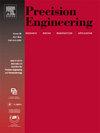Design and experimental validation of non-trimming polishing plate for high wear-resistant workpieces based on optimized motion trajectory distribution
IF 3.5
2区 工程技术
Q2 ENGINEERING, MANUFACTURING
Precision Engineering-Journal of the International Societies for Precision Engineering and Nanotechnology
Pub Date : 2025-02-03
DOI:10.1016/j.precisioneng.2025.02.004
引用次数: 0
Abstract
During the polishing of high wear-resistant workpieces, achieving uniform wear on the polishing plate is crucial for enhancing the accuracy of the workpiece and prolonging the service life of the polishing plate. The trajectory of workpiece movement on the polishing plate significantly influences its wear uniformity, especially for workpieces with high hardness and wear-resistance. In this paper, a novel design method for polishing plate tailored for high wear-resistant workpieces was proposed. The structure of the polishing plate was designed to enhance the uniformity of wear, thereby improving the surface accuracy of the workpiece. This method involves establishing kinematic models and calculating polishing trajectories. The relationship between trajectory and wear was analyzed. Consequently, an equal wear polishing plate (EWPP) was designed and manufactured based on the trajectory analysis. Using SiC as the workpiece, a comparative experiment was conducted with a normal polishing plate (NPP) and the newly designed EWPP to verify the effectiveness of the design method. The reasons for the wear of polishing plate and the formation of shape errors in workpieces were discussed. The results demonstrate that wear of polishing plate critically affects the workpiece accuracy, while the shape error of workpiece is effectively suppressed by using EWPP. This innovation improves the machining efficiency of wafer and extends the lifespan of polishing plate, offering a novel approach to improve the processing efficiency and shape accuracy of high wear-resistant workpieces.

基于优化运动轨迹分布的高耐磨工件无修边抛光板设计与实验验证
在高耐磨工件的抛光过程中,实现抛光板的均匀磨损对于提高工件的精度和延长抛光板的使用寿命至关重要。工件在抛光板上的运动轨迹对抛光板的磨损均匀性有显著影响,特别是对于硬度高、耐磨性好的工件。提出了一种适合高耐磨工件的抛光板设计方法。对抛光板的结构进行了设计,增强了磨损的均匀性,从而提高了工件的表面精度。该方法包括建立运动学模型和计算抛光轨迹。分析了轨迹与磨损的关系。在此基础上,设计并制造了基于轨迹分析的等磨损抛光片。以SiC为工件,与普通抛光板(NPP)和新设计的EWPP进行了对比实验,验证了设计方法的有效性。讨论了抛光板磨损和工件形状误差形成的原因。结果表明,抛光板磨损严重影响工件精度,而采用EWPP可有效抑制工件形状误差。这一创新提高了晶圆的加工效率,延长了抛光板的使用寿命,为提高高耐磨工件的加工效率和形状精度提供了新的途径。
本文章由计算机程序翻译,如有差异,请以英文原文为准。
求助全文
约1分钟内获得全文
求助全文
来源期刊
CiteScore
7.40
自引率
5.60%
发文量
177
审稿时长
46 days
期刊介绍:
Precision Engineering - Journal of the International Societies for Precision Engineering and Nanotechnology is devoted to the multidisciplinary study and practice of high accuracy engineering, metrology, and manufacturing. The journal takes an integrated approach to all subjects related to research, design, manufacture, performance validation, and application of high precision machines, instruments, and components, including fundamental and applied research and development in manufacturing processes, fabrication technology, and advanced measurement science. The scope includes precision-engineered systems and supporting metrology over the full range of length scales, from atom-based nanotechnology and advanced lithographic technology to large-scale systems, including optical and radio telescopes and macrometrology.

 求助内容:
求助内容: 应助结果提醒方式:
应助结果提醒方式:


